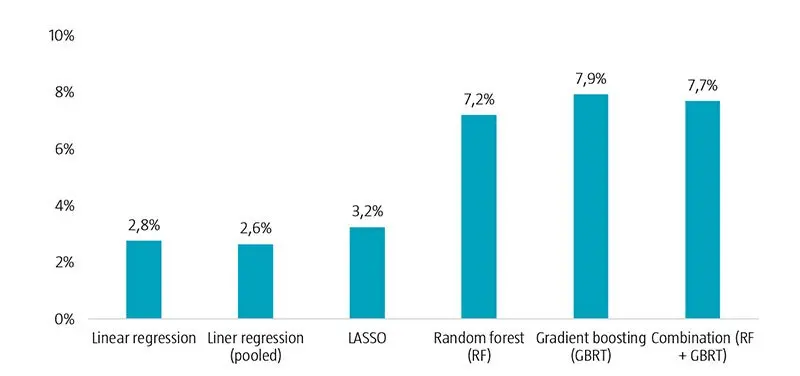Fundamental analysis is an approach that is used to determine the intrinsic or fair value of a firm and forms the basis of evaluating whether the company is undervalued or overvalued. Investors can potentially gain from such assessments if they subscribe to the notion that a company’s share price converges to its fair value over the long run: either by buying undervalued stocks or selling overvalued ones.
According to the academic literature, fundamental analysis is typically based on highly stylized valuation approaches such as discounted cashflow models which require inputs such as cashflow forecasts and discount rates. This approach is complicated by the discretion a researcher has over the choice of variables and parameters of the model.
Although these stylized models are extremely popular, explicit cash flow forecasts and discount rates are not necessarily required for fundamental analysis. For instance, an agnostic approach can estimate the fair value of a company as a linear function of its balance sheet, income statement and cashflow statement items.
To this end, a direct approach for estimating fair values is proposed by Bartram and Grinblatt in two academic studies.1 They “take the view of a statistician with little knowledge of finance” and use LR to proxy the “peer-implied fair value” of a firm as a linear function of 21 commonly reported accounting items. They conclude in their findings that their signal reliably predicts future returns in the US and most regions in the world, with the exception of the European market.
Taking a data scientist approach in valuing stocks
In a recent research paper,2 Hanauer, Kononova and Rapp opt for a different approach as they “take the view of a data scientist with little knowledge of finance”. Inspired by the studies of Bartram and Grinblatt, they apply LR and ML methods to estimate the monthly fair values of stocks from 17 European countries for the period January 1993 to December 2019. Then, based on the results, they assess the return predictability of the corresponding mispricing signals, i.e., the difference in model-based fair values and actual market values.
In their analysis, the researchers determined the fundamental values of stocks using six different approaches based on:
a LR model that closely followed the one set out by Bartram and Grinblatt,
a linear model on the pooled cross section of stocks from the last 48 months that they used for the other approaches (LR pooled),
a model using the least absolute shrinkage and selection operator (LASSO) to the 21 accounting variables,
a random forest model (RF),
a gradient boosting model (GBRT), and
a model that combines the RF and GBRT signals.
More specifically, the researchers used RF and GBRT models given that these can deal with nonlinearities and interactions, handle noisy features well, and do not require subtle tuning as is the case for more complex methods.
ML-based signals are effective in spotting mispricing opportunities
The researchers sorted the stocks into five quintile portfolios based on the various mispricing signals. They observed that all the models reflected large negative (positive) mispricing signals for the first (fifth) quintile portfolios. Interestingly, the LASSO and ML signals were considerably smaller than their LR counterparts due to the nonlinearity of their valuation models and ability to better fit the data.
To assess the efficacy of the models, they calculated the value-weighted and industry-adjusted monthly portfolio returns to study the relationship between the mispricing signals and subsequent monthly returns. As depicted in Figure 1, they saw that the ML approaches generated statistically and economically significant industry-adjusted return spreads, benefiting uniformly from both long and short positions. While the LR and LASSO signal spreads were significant, their economic relevance was substantially weaker, with a higher portion of their returns coming from the short leg.
Figure 1 | ML-based models displayed efficacy in predicting fundamental values

Source: Refinitiv, Robeco. The figure shows the annualized Fama-French six-factor alphas for long minus short quintile portfolio returns based on mispricing signals obtained from different models. The quintile portfolio returns are value-weighted and industry adjusted. The sample period is January 1993 to November 2019.
The researchers also verified the results by taking into account four different factor models. In their tests, they noted that the returns of the LR strategy were largely explained by the common factors. Similarly, the alphas for the LR (pooled) signal decreased. By contrast, the ML models delivered similar or even stronger alphas across all factor models. As such, ML methods seem to detect hidden nonlinearities that are important in predicting the fundamental value of stocks.
Conclusion
ML methods are expected to discover additional structure in data due to their ability to spot nonlinear patterns. Consistent with this view, this analysis shows that the portfolio spreads based on ML mispricing signals can earn large and significant alphas, and outperform corresponding LR mispricing models. These findings suggest that it is important to allow for nonlinearities and interactions in fundamental analysis.
At Robeco, we are convinced that developments in alternative data, artificial intelligence and ML are pivotal to the evolution of investing. We are currently investigating many ML applications that can potentially be of use for quantitative, fundamental and sustainable investing. Importantly, we follow a strict process when testing new variables or methods and stick to our investment philosophy that is based on robust empirical evidence, sound economic rationale and a prudent approach.
重要事項
当資料は情報提供を目的として、Robeco Institutional Asset Management B.V.が作成した英文資料、もしくはその英文資料をロベコ・ジャパン株式会社が翻訳したものです。資料中の個別の金融商品の売買の勧誘や推奨等を目的とするものではありません。記載された情報は十分信頼できるものであると考えておりますが、その正確性、完全性を保証するものではありません。意見や見通しはあくまで作成日における弊社の判断に基づくものであり、今後予告なしに変更されることがあります。運用状況、市場動向、意見等は、過去の一時点あるいは過去の一定期間についてのものであり、過去の実績は将来の運用成果を保証または示唆するものではありません。また、記載された投資方針・戦略等は全ての投資家の皆様に適合するとは限りません。当資料は法律、税務、会計面での助言の提供を意図するものではありません。 ご契約に際しては、必要に応じ専門家にご相談の上、最終的なご判断はお客様ご自身でなさるようお願い致します。 運用を行う資産の評価額は、組入有価証券等の価格、金融市場の相場や金利等の変動、及び組入有価証券の発行体の財務状況による信用力等の影響を受けて変動します。また、外貨建資産に投資する場合は為替変動の影響も受けます。運用によって生じた損益は、全て投資家の皆様に帰属します。したがって投資元本や一定の運用成果が保証されているものではなく、投資元本を上回る損失を被ることがあります。弊社が行う金融商品取引業に係る手数料または報酬は、締結される契約の種類や契約資産額により異なるため、当資料において記載せず別途ご提示させて頂く場合があります。具体的な手数料または報酬の金額・計算方法につきましては弊社担当者へお問合せください。 当資料及び記載されている情報、商品に関する権利は弊社に帰属します。したがって、弊社の書面による同意なくしてその全部もしくは一部を複製またはその他の方法で配布することはご遠慮ください。 商号等: ロベコ・ジャパン株式会社 金融商品取引業者 関東財務局長(金商)第2780号 加入協会: 一般社団法人 日本投資顧問業協会
